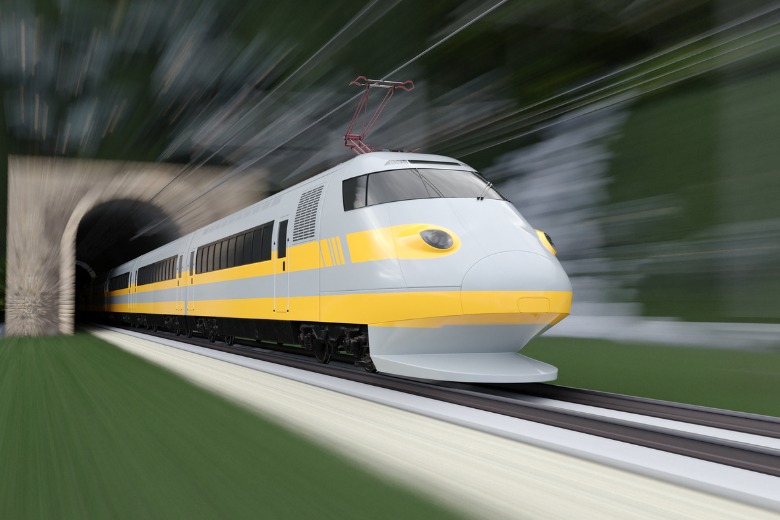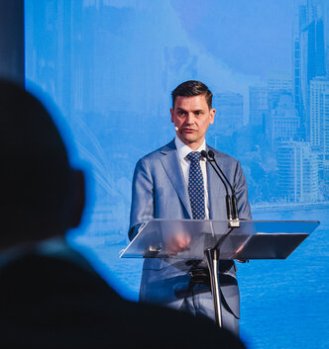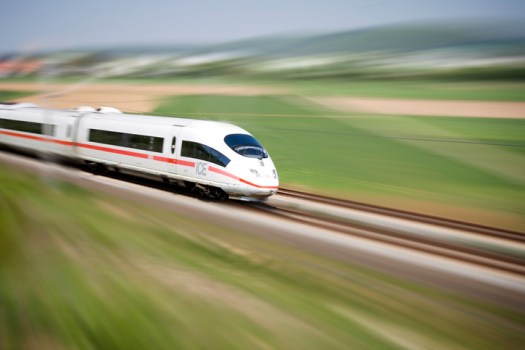
Developing an east coast high speed rail won’t be quick, cheap or easy, the head of the agency responsible for its development has told a rail industry conference.

High Speed Rail Authority (HSRA) acting CEO Andrew Hyles acknowledged during a keynote address to the Australasian Railway Association’s AusRAIL PLUS 2023 that there’s scepticism around the project, but said the benefits outweighed any costs.
It comes after revelations in October that there’s been no detailed planning for the project yet, and Mr Hyles’ admission earlier this week that the cost of the project is likely to exceed current estimates of $114 billion.
“I acknowledge that there is scepticism about building high speed rail in Australia and it will not be quick or easy,” Mr Hyles told conference delegates in Sydney on Thursday.
“Constructing high speed rail has a high cost no matter where it’s built around the world, and Australia will be no different.”
He said a “range of key issues” still had to be resolved to make HSR a reality, and it was essential to get the planning right to protect against potential future unexpected cost increases and time delays.
We are alive to the fact that building high speed rail in Australia faces challenges.
HSRA CEO Andrew Hyles
“While the opportunities of high speed are evident, we are alive to the fact that building high speed rail in Australia faces challenges. These include funding, land acquisition, managing sensitive environment and heritage issues and the time needed to plan and complete the build,” he said.
“Many issues still need to be tested and resolved, and we need to develop and set in stone the technical and operation standards that will define what sort of high speed system is built.”
He also said a lot had changed since the government released its 2013 High Speed Rail report and a number of assumptions contained in it were no longer current, including the likelihood of a high speed rail terminal at Roma Street in Brisbane.
HSRA planning its plan
Mr Hyles said the HSRA is currently planning its Pathway to Delivery report on the rail line, and a detailed business case for the Sydney to Newcastle section.
The Pathway to Delivery report, due to be completed in 2025, will include information about station locations, patronage forecasts, financial estimates and timeframes for delivery. Work on the report will begin next year.
The Sydney to Newcastle business case is scheduled to be finished in 2026.
Mr Hyles said building high speed rail would bring many benefits including a fast, efficient, low-emissions mass transit option and economic opportunities for regional areas.
“Doing nothing is not an option,” he said.
“Australia is growing by the size of Canberra every 18 months and we’ll need our regional transport infrastructure to match that growth.”
Winning hearts and minds
Meanwhile, in a keynote titled Now is the time for Australia to make High Speed Rail a Reality, Chairman of the International High Speed Rail Authority Masafumi Shukuri said an HSR between Melbourne and Sydney would reduce congestion, cut travel time and emissions and improve quality of life.

“One of the vital aspects of planning HSR is to look at what sort of new cities should be developed around the stations,” Mr Shukuri said through a translator.
“In that context having an encompassing economic plan around new development is very important.”
He also said governments needed to clearly demonstrate the benefits of HSR to get the community on board.
“The benefits of HSR are not always clear to the public,” he said. “To win hearts and minds it is necessary to show benefits to the people.”
The HSRA formally began operations on June 13 tasked with advising on, planning, developing and overseeing the construction of a high-speed east coast rail network that will allow passengers to travel between major cities and regional cities faster than 250 km/h.
The agency has received $500 million from the federal government to plan and do corridor works for the Sydney to Newcastle section of the network.
At a budget estimates hearing on October 23 Mr Hyles admitted that the HSRA hadn’t yet “kicked off detailed planning”.
“Obviously we have an extensive project of planning that we have to undertake to look at the east coast high-speed rail network, he told the hearing. “That planning will kick off later this year or at the start of next year.”
Earlier this week Mr Hyles told an AFR Infrastructure Summit that the cost of the rail line would “realistically be higher” than the $114 billion estimated in 2013.
Comment below to have your say on this story.
If you have a news story or tip-off, get in touch at editorial@governmentnews.com.au.
Sign up to the Government News newsletter

As Mr Shukuri said “what sort of new cities should be developed around the stations” is a key aspect of long term planning for HSR and whilst the focus of the HSRA is on Newcastle (really Hunter more broadly) to Sydney, it is the Federal Government’s constitutional right to buy and own land for the corridor, and its station precincts, that needs earliest attention in order to maximise Value Capture; avoid inter-governmental squabbles. For Mr Hyles, he needs to get all NSW State public servants associated with his Government’s project past the hurdle of just wanting slightly faster transit times, into the true HSR world…remembering that the HSR is a long horizon investment in forestalling otherwise necessary generational upgrades to the highway.
In the meantime, invest in straightening or properly fixing existing sleepers, rails and rolling stock; enduring the Sydney to Newcastle journey in basic old trains without even proper bike hanging and no food or coffee is unpleasant. And Sydney to Melbourne is worse with trains falling off the rails. Basic good Maintenance and repairs, along with customer comfort.
Why are we still pushing for this utterly useless HSR? We need more regional passenger rail services that run at average speeds more than we need just one “super-dooper” train that runs between two large coastal cities. Yes, other countries have high speed rail, but they only aspired to those great heights after their regional passenger rail infrastructure was fully in place. That hasn’t happened in NSW. Here, we have an appalling regional rail passenger service. What is the use of establishing “Special Activation Precincts” if nearby towns aren’t going to be serviced by passenger rail services to access those new factories, warehouses and businesses that will be springing up? And what is the use of establishing new “Renewable Energy Zones” if towns in these areas aren’t going to be serviced by passenger rail services to attract people to move there or establish businesses there? And what is the point of encouraging new migrants to relocate to the regions if they can’t access passenger rail services? People need access to public transport across the entire state, not just between Sydney and Newcastle. And with the cost of living spiralling out of control, soon many people will be relying wholely and solely on public transport to get around, particularly young people, young families and pensioners. What needs to happen is for the NSW Government to urgently reassess their rail transport priorities. The future of this state does not lie on growing Sydney’s population, or getting those people whizzing between Newcastle and Sydney at high speed. It lies in expanding the population across the regions. Decentralisation is the key to this state’s prosperity, not building thousands of future ghettos in the city. So instead of having an office dedicated to HSR, what is really needed is an office dedicated to Regional Average Speed Passenger Rail or (RASPR). ASo give the regions back their passenger trains if you are serious about boosting the future prosperity of this state, as HSR isn’t going to help anyone in this state get ahead any time soon.
Setup to fail!
We pick the Hardest and most expensive part of the Northern corridor as the First flagship project. This involves a lot of Tunneling out of the Sydney basin North Yes it is mostly sandstone and a big bridge across the Hawkesbury river and a few more tunnels even to get to Gosford!
Perhaps a more strategic First HSR project. Like the Proposes Sydney to Canberra corridor might be a better flagship project.
So we have a proof of concept.
Would allow Regional transport SW of NSW to be improved as a bonus in a much quicker to construction time than whats proposed!
Given the NSW Government studies on the Sydney – Newcastle Corridor I hope the HSRA will make the first on the ground steps to deliver greater capacity and improved travel times during 2024.
More planning to plan for Heaven’s sake??? Why is this so difficult for Australia? Could you imagine the Japanese, French or Chinese procrastinating like we have for decades? Enough talk. Just get on with it and start reserving corridors…
I cannot believe how the Federal and State Government can be so fixated on the HSR idealism. Tracks on ground are old school and cause far too much maintenance, repair etc. Governments should explore all avenues of technology for the best, cheapest and safest forms of transport. The string system is a far better transport system and can carry multiple carriages on one line whilst also running containers on a line above the Passenger line. They are suspended from towers that take up far less area than conventional rail, have greater comfort for passengers and they travel at 250 to 500 kms an hour.
Great Britain is building HSR from London to the north, this means trains travel from London to the end of the HS line and then slow to travel to their final destination on the old tracks. A similar project in NSW on the proposed HS route towards Melbourne would improve regional train services to southern NSW towns (and Canberra), and generate income for HS rail earlier.
What never gets mentioned about HSR is poor traction steel wheels on steel rails. For acceleration it takes 30km of straight track to accelerate to 300kmh. Similarly for braking. Shallow maximum gradient for ascend/descend. Also curves need to be very large radius at high speed. Big meanderings huge earth moving, plenty maintenance.
Much fuss about new track for train from CBD to Tullamarine airport is 30 minute transit time, assuming no congestion.
Maglev would be 4mins 58 secs, less, if allowed faster than 300kmh. Last bid by Transrapid before they pulled the pin in 2008, was Geelong to Tullamarine to Frankston for $8.5Billion. Transrapid had just finished 32km system, Shanghai joint venture, in 4 years from contract sign until operational. Always elevated not affecting ground activities and floating on air, no wear and tear contact, using 70% less energy than HSR.
Surely HSR is technology from 19th century, slightly faster than Flying Scot at 192kmh?